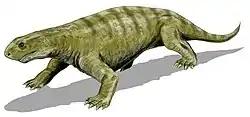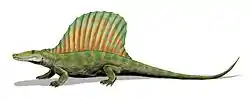Protoclepsydrops
Protoclepsydrops is an extinct genus of early synapsids, found in Joggins, Nova Scotia.[1] The name means 'first Clepsydrops', and refers to it being the predecessor of the other early synapsid Clepsydrops.
| Protoclepsydrops | |
|---|---|
| Scientific classification | |
| Kingdom: | Animalia |
| Phylum: | Chordata |
| Clade: | Amniota |
| Clade: | Synapsida (?) |
| Genus: | †Protoclepsydrops Carroll, 1964 |
| Type species | |
| †Protoclepsydrops haplous Carroll, 1964 | |
Description
Like Archaeothyris, Protoclepsydrops resembled a modern lizard in superficial appearance. However, Protoclepsydrops had primitive vertebrae with tiny neural processes typical of their amniote ancestors. Protoclepsydrops is known from a few vertebrae and some humeri.[2]
Classification
Its skeletal remains indicate that it may have been more closely related to synapsids than to sauropsids, making it a possible stem-mammal. If so, it is the oldest synapsid known, though its status is unconfirmed because its remains are too fragmentary. Protoclepsydrops lived slightly earlier than Archaeothyris.[3]
See also
- List of pelycosaurs
- Evolution of mammals
- List of transitional fossils
- Carboniferous tetrapods
- Clepsydrops
References
- Carroll, Robert L. (1964). "The earliest reptiles". Journal of the Linnean Society of London, Zoology. 45 (304): 61–83. doi:10.1111/j.1096-3642.1964.tb00488.x.
- Reisz, R., 1972. Pelycosaurian reptiles from the middle Pennsylvanian of North America. Harvard University.
- Benton M.J. and Donoghue P.C.J. 2006. Palaeontological evidence to date the tree of life. Molecular biology and evolution. 24(1): 26–53.



